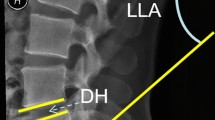Abstract
Minimally invasive lumbar fusion techniques have only recently been developed. The goals of these procedures are to reduce approach-related soft tissue injury, postoperative pain and disability while allowing the surgery to be conducted in an effective manner. There have been no prospective clinical reports published on the comparison of one-level transforaminal lumbar interbody fusion in low-grade spondylolisthesis performed with an independent blade retractor system or a traditional open approach. A prospective clinical study of 85 consecutive cases of degenerative and isthmic lower grade spondylolisthesis treated by minimally invasive transforaminal lumbar interbody fusion (MiTLIF) or open transforaminal lumbar interbody fusion (OTLIF) was done. A total of 85 patients suffering from degenerative spondylolisthesis (n = 46) and isthmic spondylolisthesis (n = 39) underwent one-level MiTLIF (n = 42) and OTLIF (n = 43) by two experienced surgeons at one hospital, from June 2006 to March 2008 (minimum 13-month follow-up). The following data were compared between the two groups: the clinical and radiographic results, operative time, blood loss, transfusion needs, X-ray exposure time, postoperative back pain, length of hospital stay, and complications. Clinical outcome was assessed using the visual analog scale (VAS) and the Oswestry disability index. The operative time, clinical and radiographic results were basically identical in both groups. Comparing with the OTLIF group, the MiTLIF group had significantly lesser blood loss, lesser need for transfusion, lesser postoperative back pain, and shorter length of hospital stay. The radiation time was significantly longer in MiTLIF group. One case of nonunion was observed from each group. Minimally invasive TLIF has similar surgical efficacy with the traditional open TLIF in treating one-level lower grade degenerative or isthmic spondylolisthesis. The minimally invasive technique offers several potential advantages including smaller incisions, less tissue trauma and quicker recovery. However, this technique needs longer X-ray exposure time.

Similar content being viewed by others
References
Cloward RB (1982) History of PLIF: forty years of personal experience. In: Lin PM (ed) Posterior lumbar interbody fusion. Charles C. Thomas, Springfield, pp 58–71
Cloward RB (1953) The treatment of ruptured intervertebral discs by vertebral body fusion: Part I—indications, operative technique, after care. J Neurosurg 10:154–168
Steffee AD, Sitkowski DJ (1988) Posterior lumbar interbody fusion and plates. Clin Orthop Relat Res 227:99–102
Harms JG, Jeszenszky D (1998) The unilateral transforaminal approach for posterior lumbar interbody fusion. Orthop Traumatol 6:88–89
Humphreys SC, Hodges SD, Patwardhan AG et al (2001) Comparison of posterior and transforaminal approaches to lumbar interbody fusion. Spine 26:567–571
Kawaguchi Y, Matsui H, Tsuji H (1996) Back muscle injury after posterior lumbar spine surgery. A histologic and enzymatic analysis. Spine 21:941–944
Kawaguchi Y, Matsui H, Tsuji H (1994) Back muscle injury after posterior lumbar spine surgery. Part 2: histologic and histochemical analyses in humans. Spine 19:2598–2602
Sihvonen T, Herno A, Paljiarvi L et al (1993) Local denervation atrophy of paraspinal muscles in postoperative failed back syndrome. Spine 18:575–581
Styf JR, Willen J (1998) The effects of external compression by three different retractors on pressure in the erector spine muscles during and after posterior lumbar spine surgery in humans. Spine 23:354–358
Isaacs RE, Podichetty VK, Santiago P et al (2005) Minimally invasive microendoscopy-assisted transforaminal lumbar interbody fusion with instrumentation. J Neurosurg Spine 3:98–105
Schwender JD, Holly LT, Rouben DP et al (2005) Minimally invasive transforaminal lumbar interbody fusion (TLIF): technical feasibility and initial results. J Spinal Disord Tech 18(Suppl):S1–S6
Scheufler KM, Dohmen H, Vougioukas VI (2007) Percutaneous transforaminal lumbar interbody fusion for the treatment of degenerative lumbar instability. Neurosurgery 60:203–212
Ozgur BM, Yoo K, Rodriguez G et al (2005) Minimally invasive technique for transforaminal lumbar interbody fusion (TLIF). Eur Spine J 14:887–894
Schizas C, Tzinieris N, Tsiridis E et al (2008) Minimally invasive versus open transforaminal lumbar interbody fusion: evaluating initial experience. Int Orthop 33(6):1683–1688 (published online 21 November)
Kambin P (1993) Arthroscopic microdiscectomy of the lumbar spine. Clin Sports Med 12:143–150
Mummaneni PV, Rodts GE Jr (2005) The mini-open transforaminal lumbar interbody fusion. Neurosurgery 57:256–261
Kim DH, Albert TJ (2002) Update on use of instrumentation in lumbar spine disorders. Best Pract Res Clin Rheumatol 16:123–140
Ringel F, Stoffel M, Stuer C et al (2006) Minimally invasive transmuscular pedicle screw fixation of the thoracic and lumbar spine. Neurosurgery 59(4) Operative Neurosurgery Supplement 2:ONS361–ONS366
Acknowledgments
No funds were received in support of this work. No benefits in any form have been or will be received from a commercial party related directly or indirectly to the subject of this manuscript.
Author information
Authors and Affiliations
Corresponding author
Additional information
The device(s)/drug(s) is/are FDA-approved or approved by corresponding national agency for this indication.
Rights and permissions
About this article
Cite this article
Wang, J., Zhou, Y., Zhang, Z.F. et al. Comparison of one-level minimally invasive and open transforaminal lumbar interbody fusion in degenerative and isthmic spondylolisthesis grades 1 and 2. Eur Spine J 19, 1780–1784 (2010). https://doi.org/10.1007/s00586-010-1404-z
Received:
Revised:
Accepted:
Published:
Issue Date:
DOI: https://doi.org/10.1007/s00586-010-1404-z




